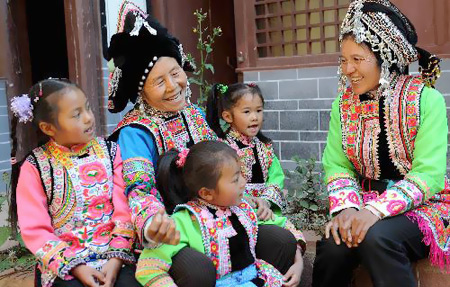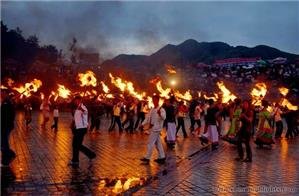1 Answer
Yi People

Yi people mainly live in provinces of Sichuan, Yunnan and Guizhou, and Guangxi Zhuang Autonomous Region, with a population of 7,762,000. Most Yi people are scattered in mountainous areas at high altitudes, and a small number of them live on flat land or in valleys.
The Yi ethnic group has its own speaking and written language. Yi language belongs to the family of Tibetan-Cambodian of Sino-Tibetan system, and has six dialects. They used to have a syllabic script, and each syllable has its meaning. The script was formed in the 13th century, and has about 10,000 words, among which about 1,000 are in daily use. Most Yi people can also use Mandarin Chinese.
History
Historical records show that the ancestors of the Yi people were closely related with ancient Qiang people in West China. The activities of the ancient Yi people were centered around Dianchi Lake area in Yunnan Province, and were later extended to other parts of Yunnan Province, and to Sichuan, Guizhou and Guangxi provinces.
Eating Habits
In most Yi areas, corn, buckwheat, and potatoes are the staple food. Meat includes beef, pork, mutton, chicken and so on. They like cooking meat in large joints, and meats of dog, horse, snake, and frog are forbidden. Sour and spicy are their favorite tastes.
Wine takes up an important role in Yi people’s eating customs. They treat guests with wine, and drink wine on various occasions. There is a drinking manner called Zhuanzhuanjiu (drinking wine in turns). People pour the wine in a big bowl and sit in a circle. The oldest will take the first sip, wipe the bowl edge and pass it to the next one. People drink the wine in turn until it is finished.
Yi people living in northeast Yunnan Province have an interesting ancient tradition called Tiaocai (dancing while serving dishes). On celebrating occasions, after the dishes are ready and the guests have taken seat, the Tiaocai begins. Tiaocai masters carry the dishes on the plates as well as on the head. Sometimes one person can carry more than 20 dishes at a time. Carrying the dishes, they jump and swing to the rhythm of drums and suona (Chinese clarinet), and serve the dishes to the tables. It is amazing that not even a single drop of the soup is spilled during the process.
Architectural Style
The Yi people inhabiting in mountainous areas live in adobe houses with flat roofs used as a veranda. There are usually 3 – 5 rooms. Right in the middle is the living room, where the family members gather around, or entertain visiting guests. On the left side near the wall, there is a hearth laid by 3 stones, with a pot hanging above. This is called a Guozhuang (pot hanging over a hearth). Tramping or leaping over the Guozhuang is considered ominous. People use the hearth to prepare meals, stay warm, and for lighting. All the family members, young and old, sit around the hearth, talking and singing – this is a place to pass down their culture from generation to generation.
Costumes
The Yi people’s traditional costumes vary in different regions, . In Mt. Liangshan area in Sichuan Province and west Guizhou, men usually wear black jackets with tight sleeves and right-side askew fronts, and pleated trousers with wide bottom. While in some other areas, men wear tight-bottomed trousers, and grow a small path of hair above the forehead to be tied with a turban.
Women wear embroidered jackets and pleated long skirts hemmed with multiple layers. They use turbans to wrap their hair. Middle-aged women wear black turbans, while young women prefer embroidered square kerchiefs. Their accessories include earrings, bracelets, rings, collar press, and so on. When going outdoors, men and women wear a dark woolen cape with long tassels reaching to the knees.
Custom
In Mt. Liangshan and Lesser Mt. Liangshan areas, a ceremony known as ‘Shalaluo’in the Yi dialect has been observed for many generations. Shalaluo is an adult ceremony for the girls, meaning taking off a girl’s skirt and putting on an adult one. Before the ceremony, girls wear red-and-white dresses, one ponytail, and thread their earlobe with floss. After the ceremony, they will wear long skirts with blue and black colors in the middle, make their hair into two braids, and they also begin to wear earrings. The ceremony usually occurs at the age of 15 or 17, depending on the girl’s situation. On the day of the ceremony, the family will prepare food in the early morning. Only girls and female relatives are allowed to attend. Only when the ceremony is finished can the men take part in the banquet. After the ceremony, the young ladies can walk freely on the streets and go to the market. They are also allowed to date men and get married.
In some Yi areas in Yunnan Province, there retains an ancient wedding custom of ‘kidnapping of the bride’, which is feigned and practiced to add to the joyous atmosphere. Actually the bride and groom, their parents and relatives have all agreed to the marriage. The groom’s family, on the one hand, will send betrothal gifts to the bride’s family, while on the other hand send people to the bride’s house at a pre-arranged time to snatch the bride and carry her home on horseback. The bride is supposed to cry for help, and her family members will pretend to chase after and attack the kidnappers with water, cudgels and stove ashes, trying to get the bride back. When the kidnappers take the bride to the groom’s house with black ashes on their faces, everybody laughs at the funny scene. As part of the ceremony, there will also be a frolic fight between the bride and groom on the wedding night.
Festivals
 Torch Festival of Yi people
Torch Festival of Yi peopleThe Torch Festival is a traditional festival for the Yi ethnic group. It falls on the 24th of the sixth month of the Chinese calendar, and the celebration lasts for 3 days. The origin of the festival is related to ancestors’ worshipping of the fire, which is believed to have the power to repel insects, ward off evils, and protect the growth of crops. In some villages, it is a tradition for the elderly to pass down their farming experience to the younger generation during the festival.
During the festival, big torches are erected in the village, while small torches are placed in front of each household. When the night falls, an altar is set up and the holy flame is lit up. The Bimo (village flamen) will chant prayers, light up torches from the flame, and pass them to the villagers. Villagers, holding the flame, walk around the village, houses and the fields, and place the torches in the field corners to drive away evils. Inside the village, young men and women sing and dance around bir burning torches throughout the night.
http://www.chinahighlights.com/travelguide/nationality/yi.htm
| 9 years ago. Rating: 3 | |

 rca567
rca567
 country bumpkin
country bumpkin




